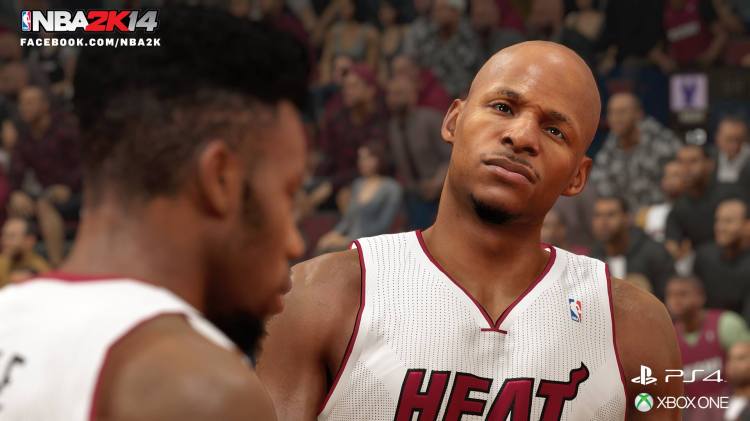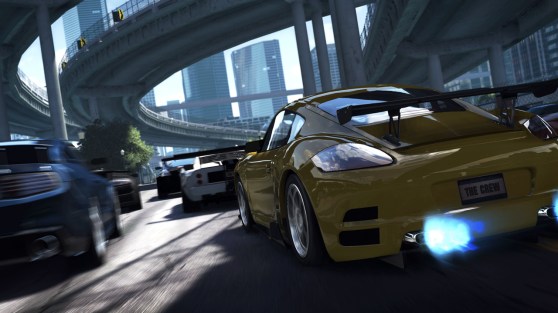This is part of our ongoing series about games and trends of the upcoming next generation.
NEW YORK CITY — Better dribbling, more realistic crowds, and networking features are just some of the ways that developers are working to make familiar genres like sports and racing games better on the next-gen consoles.
At a PlayStation 4 event, we played all of the system’s sports and racing launch games, and we asked each developer how they are taking advantage of the new consoles to ensure that it’s really worth upgrading.
All of the games look better. Some have incredible new online features. Others even use the new controllers in interesting or gimmicky ways. We’ve gathered all of the developers’ thoughts here, so you can see how your favorite virtual sports and racing titles will improve thanks to a $400 or $500 new console.
A graphical leap forward
This is obvious. Games should look better on a PS4 than they do on a PS3, and sports/racing games do enjoy a graphical boost on next gen. It’s not just more polygons or better textures, either, although studios are definitely starting with that.
“We really just cranked up the graphics,” Madden NFL designer Patrick Bellance told GamesBeat. “We took all the assets we were using from [current gen] and in some cases quadrupled them — and in some case up to 10 times the size of these same assets. So the amount of depth in the textures is in a place that we’ve never been at before.”
This level of detail can make a difference when gamers zoom in on a jersey during instant replay — things like the stitch lines and how the shirt’s weave start to appear.
This doesn’t just work with things like fabrics and human skin. In Need For Speed: Rivals, for example, rain-slicked roads are mesmerizingly detailed.
The extra power of the next-gen games also (finally) enabled the developer of every sports game to create more realistic crowds. Instead of the cardboard cutouts we’ve all seen endlessly for years now, games like FIFA 14 feature polygonal crowds that have their own artificial-intelligence routines.
“The 3D crowd is brand new. That’s something we were never able to do before,” FIFA producer Santiago Jaramillo told GamesBeat. “We can create this atmosphere that we call living worlds.”
Jaramillo said that this is only possible thanks to the power of the next-gen consoles.
“Before, if you played FIFA 13, we just couldn’t load 60,000 to 70,000 3D-rendered fans,” he said. “It even allows us to have better animations for the crowd.”
The overall fidelity of animations is another area where developers are making strides thanks to the improved horsepower they’re working with. NBA Live 14’s developer finally has the capability to separate the ball from the hand, and make dribbling look and work realistically.
“Just go play any basketball game when you get home and spam the left stick and tell me what happens,” NBA Live 14 gameplay designer Scott O’Gallagher told GamesBeat. “The character will start shaking and pausing in weird ways because the game is so worried about what the player is doing.”
O’Gallagher then showed off how how when he quickly jutted the left stick from side to side, NBA Live 14 easily caught up with the motions and created a realistic onscreen presentation. The basketball would bounce, and as it came back to the player’s hand, his whole body would adjust and he immediately performed the next move.
NBA 2K14 looks even better. In fact, after seeing more than a dozen next-gen games in action, 2K Games’ basketball title is probably the overall best-looking title. It has enhanced lighting, improved textures, better crowds, and just a cohesive realism that makes the visuals pop more than even some of the Sony first-party games.
It’s details like dribbling that really set the PlayStation 4 apart from PS3 or Xbox 360. The overall visual identities of these games is pretty similar to what we know from current gen, but when the jersey’s start to look like real fabric and the crowds begin to resemble actual fans, that’s where what you’re paying for with the PlayStation 4 and Xbox One — at least at launch.
The next thing in online features
Let’s say you’re playing a game of Madden and your power goes out. Previously, that meant you just lost every play and touchdown you scored, but not on next gen.
“You can restart an unfinished game no matter how you turned the system off,” said Bellanca. “If you hit power or pull a plug out or whatever, you can just load back in.”
This is something that the improved online infrastructure of the PS4 and Xbox One enabled the developer to accomplish. Other studios, like the team at Ubisoft producing open-world racing game The Crew, is using the improved online to make its seamless online world even better.
“Every other car on the road could be A.I., or they could be other players,” The Crew creative director Julian Gerighty told GamesBeat. “Just by meeting them, you can invite them into your crew and set asynchronous challenges for them.”
Ubisoft first accomplished something similar to this with its Test Drive Unlimited racer, but next-gen enables the company to make The Crew bigger and capable of withstanding even more players.
EA Sports is using online to accomplish something a little bit different with NBA Live 14. The developer is using the connectivity and huge hard drive of Sony’s and Microsoft’s systems to power a living database that keeps the basketball title up-to-date with the constantly changing world of the NBA in nearly real time.
“We want to evolve to the point where we have a sports game-as-a-service,” O’Gallagher said. “We want it so that whatever you see on ESPN is exactly what you get in the game.”
To accomplish that, EA Sports’ NBA studio developed an online backend where it can update the look of players on the fly. If a player breaks his nose and needs to wear one of those plastic face masks, he’ll appear that way in the game. If a superstar introduces a new line of shoes, he’ll wear those in NBA Live 14. If Lebron shows up with a new hairdo, his virtual self will get the same cut.
It doesn’t end at appearance, EA is working with basketball-analytics firm Synergy Sports Technology to develop its player intelligence. Synergy analyzes every game and tracks fine details like how many times each player breaks left or right off the dribble. That info builds up a whole profile that informs how the digital character behaves in the game. Synergy’s data updates almost instantly after a game, and EA is using that to create challenges based on actual performances that occur in the NBA from day to day. The studio can also change a players stats and A.I. as they evolve over a season.
Controller gimmicks
I asked every developer I saw if they were doing anything with the Dual Shock 4’s or Xbox One controller’s unique capabilities. Next-gen isn’t just about processors — it’s also about these improved interface devices. Out of all the studios I asked, only EA’s NBA Live 14 team utilized the controller for anything worthwhile.
When an offensive player is up against a defensive player — like when their bodies are forced against one another’s in the post — the controller (both Xbox One’s and PS4’s) will vibrate depending on the side that is doing the pressing. On PS4, at least, those vibrations have three different levels of intensity that indicate how hard the other player is pressing up against your character. If you’re on defense and the controller is vibrating like mad, you could move your character out, and it’s likely that the opponent will fall to the ground because they were putting so much force into you.
That’s an interesting way to convey information to the player using something other than audio or visual, but it is only a gimmick at this point.
Are these games really what’s next for virtual sports?
Yes, but that doesn’t necessarily mean they’re going to blow you away. If you want gorgeous visuals that are indistinguishable from reality, next-gen sports games aren’t going to deliver that yet. The graphical and aesthetic improvements are pretty minor overall with most of the separation coming in the details.
Still, these developers are finding ways to make their games stand out at launch, and the stuff they’re doing could lead to even bigger improvements in 2014.
VentureBeat's mission is to be a digital town square for technical decision-makers to gain knowledge about transformative enterprise technology and transact. Learn More


